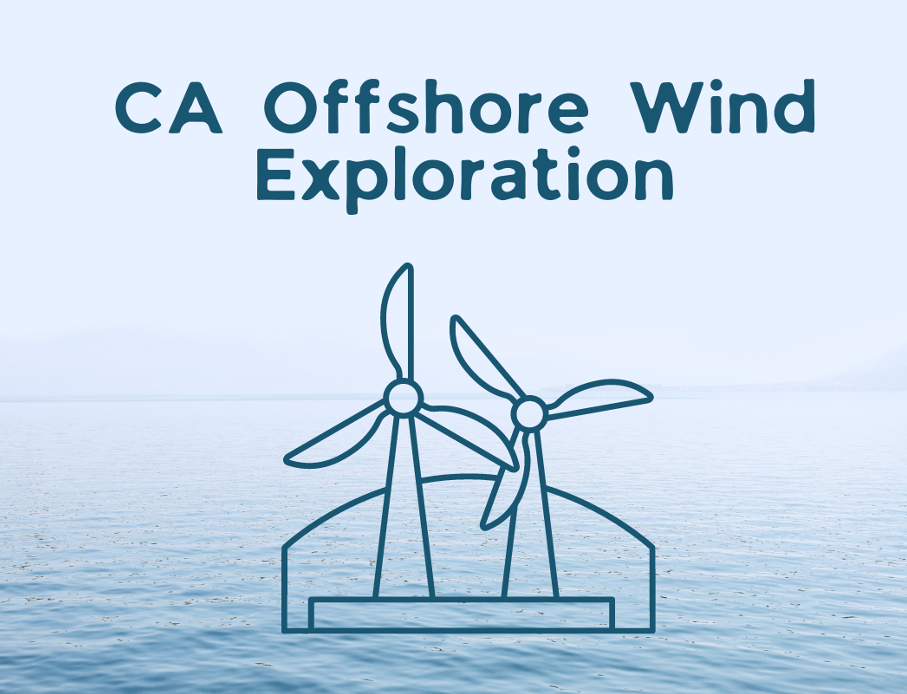Written By: Arianna Rose Soriano, MBC 2024 (a1soriano@ucsd.edu)
As a San Diegan deeply connected to the ocean through surfing, the prospect of offshore wind developments off the California coast evokes a mixture of anticipation and concern. Picture this: sitting atop a surfboard on a clear day, gazing out at the horizon, only to find it dotted with towering wind turbines. It’s a vision that raises questions about the sanctity of our coastal sanctuaries and the balance between renewable energy goals and environmental preservation.
In recent years, there’s been a notable shift in Californian’s support for offshore wind development, climbing from 72% in 2019 to a staggering 83% by 2023.[1] The surge in favorability of renewable energy could be attributable to urgency for reducing carbon emissions, combating climate change, and creating jobs in the green energy sector. Yet, beneath this consensus lies a complex tapestry of concerns regarding the potential costs to our natural landscapes and ecosystems.
To understand the intricacies of offshore wind development in California, it’s crucial to delve into the timeframe of offshore developments and regulatory framework governed by entities like the Bureau of Ocean Energy Management (BOEM)
What is happening in California? Where are we now?
- In August 2022, the California Energy Commission (CEC) adopted the AB 525 law’s first milestone, setting offshore wind planning goals of up to 5 GW by 2030 and 25 GW by 2045.
- BOEM announced five lease sales for wind energy development off the coast of Morro Bay and Humboldt County.
- In December 2022, the competitive auctions for these designated areas of the ocean attracted bids from multiple companies, totaling over $757 million.
- In June 2023, the CEC released the Offshore Wind Energy Permitting Roadmap – Final Report.
- California is now in the site assessment phase, which could take up to 5 years before construction and development.
BOEM’s Regulatory Framework
What happens during the site assessment?
BOEM conducts environmental reviews as part of the leasing process, assessing the potential impacts of proposed projects on marine life, coastal habitats, and other stakeholders. These assessments are critical for ensuring that offshore wind development is conducted in an environmentally responsible manner. Lease agreements typically include stipulations for mitigating environmental impacts and ensuring compliance with safety regulations throughout the project’s lifespan. These provisions help safeguard marine ecosystems and address concerns raised by local communities and environmental advocates.
Developers must obtain permits from various state and federal agencies, navigating a complex maze of regulatory requirements to bring offshore wind projects to fruition. This regulatory process ensures that offshore wind development proceeds in a transparent and accountable manner, with opportunities for public input and oversight.
For more detailed information on California’s offshore leases and the leasing process, visit the BOEM California State Activities webpage.
What is the impact on marine life and the fishing industry?
Offshore wind developments raise concerns regarding their potential impact on marine ecosystems and the fishing industry. Two primary technologies—floating and fixed body structures—vie for dominance in the offshore wind arena. Each comes with its own set of advantages and drawbacks, from installation costs to stability in varying sea conditions. Fixed structures exist on the East Coast, but California would adopt floating structures due to the depths of the sea floor on the West Coast.[2]
But what about the inhabitants of these underwater realms? Will the presence of wind turbines disrupt critical habitats and migration patterns, leading to unintended consequences for marine biodiversity? Moreover, what implications will offshore wind farms have for the fishing industry, whose livelihoods depend on the health of these oceanic ecosystems? Right now, these questions linger, but that is the purpose of the site assessment phase! In time, the public will be able to craft well-informed decisions as more data from environmental impacts become available.
For more insights into the impact of offshore wind developments on marine life, you can explore research articles and reports on the Ocean Conservancy website.
Visual Impact on Shoreline Views
One of the most pressing concerns surrounding offshore wind development is its potential impact on the picturesque views cherished by coastal communities. Will the installation of towering wind turbines obstruct our panoramic vistas, altering the coastal landscape forever? To my point, on a clear day in Windansea, you can see San Clemente Island (~70 miles away).
California offshore wind developments would take place in federal waters, 20 to 30 miles offshore. The turbine structures would stand slightly shorter than the height of the Eiffel Tower. Visual simulations from other coastal regions, like New Jersey, offer glimpses into what such a future might entail.[3] Yet, the extent to which these structures will intrude upon our coastal panoramas remains a subject of ongoing debate and speculation.
It’s time to talk about it!
As an environmentalist and surfer, the allure of renewable energy is undeniable, yet the potential trade-offs loom large on the horizon. We stand at a crossroads, where the promise of clean energy must be weighed against the preservation of our coastal treasures. Now more than ever, we need a clearer understanding of the impacts of offshore wind development on our marine ecosystems and shorelines.
By engaging in informed dialogue and advocating for responsible development practices, we can navigate these uncharted waters together. Let’s strive for a future where renewable energy and environmental stewardship go hand in hand, ensuring that generations to come can continue to enjoy the beauty of California’s coastline.
For opportunities to engage in public comment, please see BOEM’s A Citizen Guide.
[1] Baldassare, M., Bonner, D., Lawler, R., and Thomas, D. (2023). PPIC Statewide Survey: Californians and the Environment. Public Policy Institute of California. Link.
[2] “ Q & A on Offshore Wind California.” Offshore wind California. Link.
[3] McCrone, B. “Enjoy the View While It Lasts. Jersey Shore with 100s of Wind Turbines Revealed.” (2024). NBCUniversal Media. Link.


